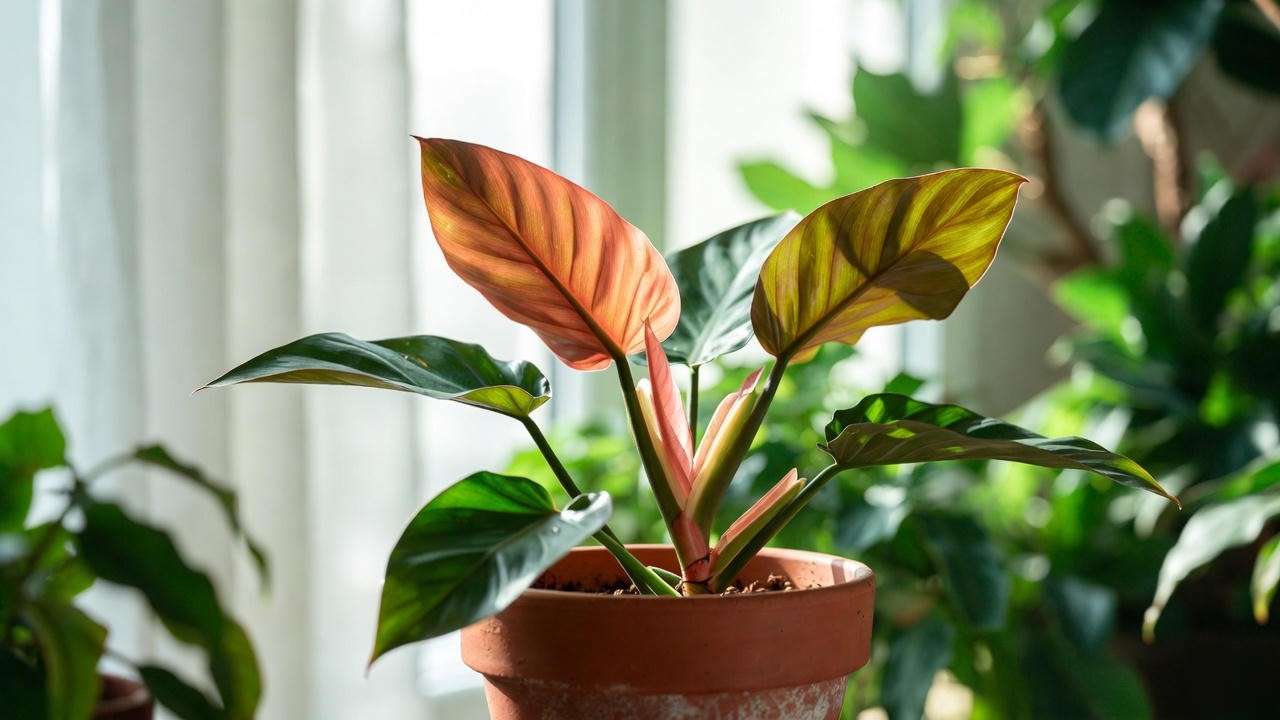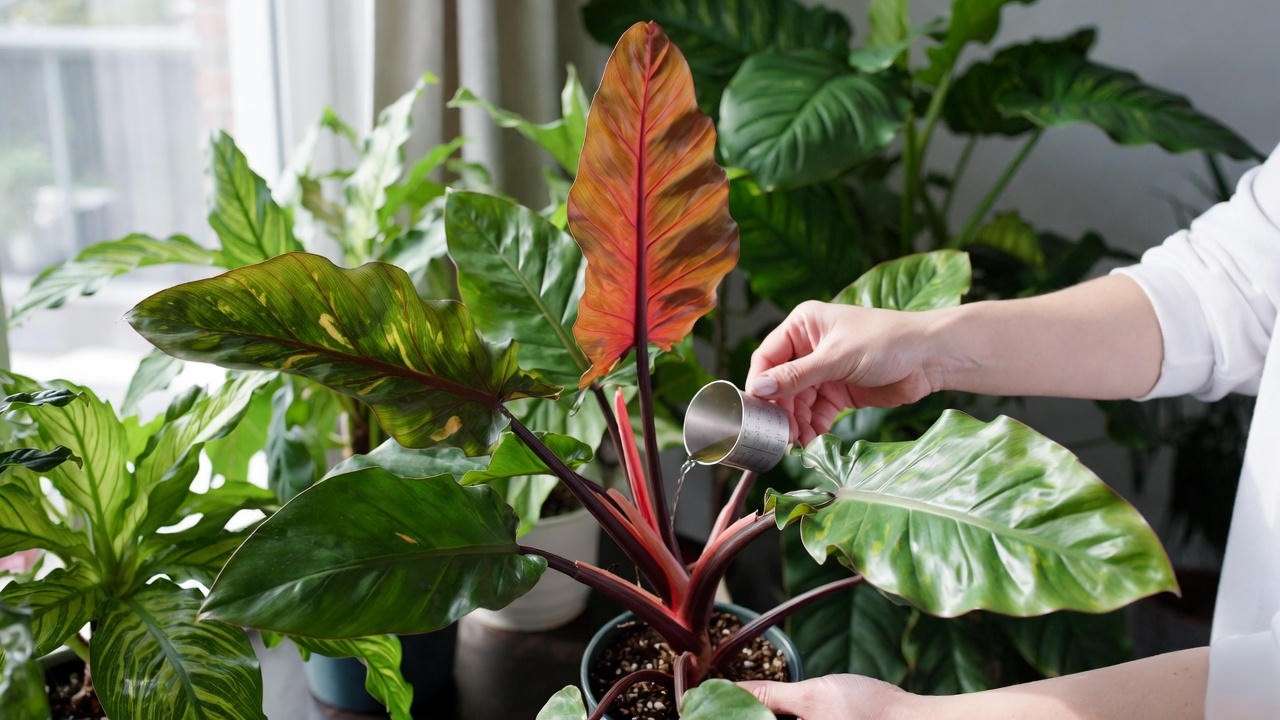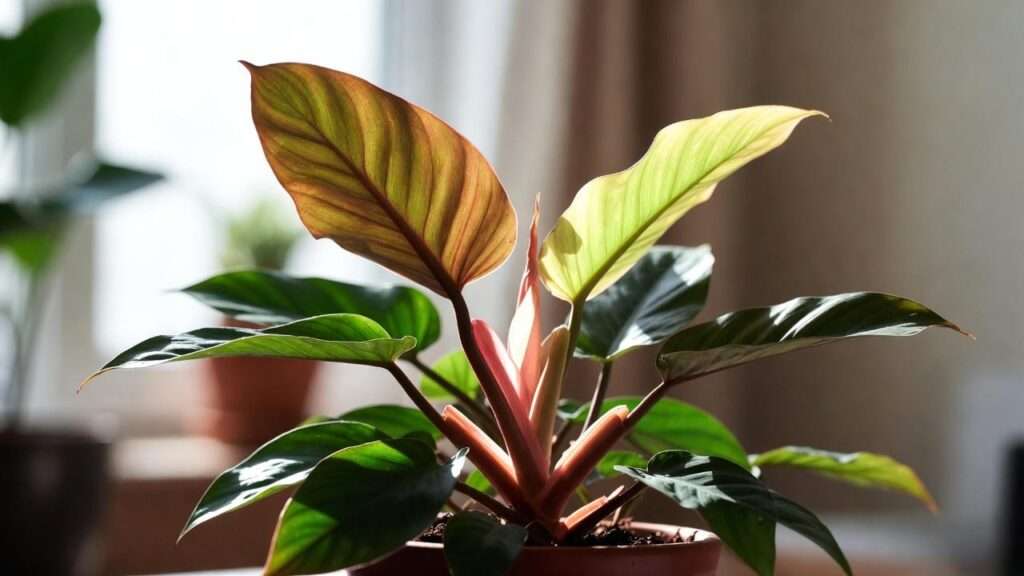Imagine a houseplant so stunning it stops guests in their tracks, with heart-shaped leaves that shimmer in shades of red, burgundy, and deep green. That’s the Philodendron Red plant, a tropical gem that’s become a favorite for plant enthusiasts everywhere. Whether you’re a newbie or a seasoned plant parent, this vibrant beauty can elevate your indoor space—but only if you know how to care for it properly. As a horticulturist with over a decade of experience cultivating tropical plants, I’ve seen firsthand how the right care transforms a Philodendron Red into a thriving centerpiece. In this guide, you’ll discover seven expert tips to keep your Philodendron Red plant lush, vibrant, and healthy, solving common care challenges and ensuring long-term success. Let’s dive in!
What Makes the Philodendron Red Plant So Special? 🌺
A Quick Overview of the Philodendron Red Family (H2)
The Philodendron Red plant isn’t just one variety—it’s a family of cultivars known for their striking, reddish-hued foliage. Popular types include Philodendron ‘Red Emerald,’ with its climbing vines and glossy leaves, ‘Imperial Red,’ a compact self-heading variety, ‘Congo Rojo,’ with bold, upright growth, and ‘Prince of Orange,’ which shifts from orange to deep green as it matures. These plants belong to the Araceae family, native to South American rainforests, making them perfect for adding tropical flair to your home. Their heart-shaped leaves and vibrant colors make them a standout, while their relatively easy care requirements suit both beginners and experts. Whether you want a trailing vine or a bushy focal point, there’s a Philodendron Red for every space.
Why Proper Care Matters for Your Philodendron Red (H2)
A well-cared-for Philodendron Red rewards you with lush, colorful foliage that can last for years. Neglect it, though, and you might face yellowing leaves, stunted growth, or even plant loss. Proper care enhances the plant’s vibrant reds and greens, prevents common issues like leaf drop, and promotes vigorous growth. For example, I once revived a client’s struggling ‘Red Emerald’ by adjusting its light and watering routine—within weeks, it was thriving again! By following the right care practices, you’ll not only keep your plant healthy but also create a stunning indoor display. This guide’s seven tips are designed to address the specific needs of your Philodendron Red, ensuring it remains a vibrant showstopper. Word count: ~120 words
Tip 1: Perfecting the Light Conditions for Your Philodendron Red ☀️
Ideal Lighting Requirements (H3)
To keep your Philodendron Red plant thriving, bright, indirect light is key. Think of the dappled sunlight filtering through a rainforest canopy—this mimics the plant’s natural habitat. Place it near an east-facing window for gentle morning light or a north-facing window for consistent, filtered light. If you only have a south- or west-facing window, use sheer curtains to diffuse the light and prevent leaf scorch. Aim for 6-8 hours of indirect light daily to maintain those vivid red tones. If your plant’s leaves start fading or losing their vibrancy, it’s likely not getting enough light. For low-light spaces, consider supplementing with a full-spectrum LED grow light (6500K is ideal) to mimic natural conditions.

Troubleshooting Light-Related Issues (H3)
Improper lighting can lead to noticeable problems. Too much direct sunlight causes brown, crispy leaf edges, while too little light results in leggy stems or dull, greenish leaves. If you notice these signs, act quickly. For sunburned leaves, move the plant to a shadier spot and trim damaged foliage. For leggy growth, relocate it to a brighter area or add a grow light. I recommend the Sansi 15W LED Grow Light for its affordability and effectiveness in small spaces. Monitor your plant’s response over a few weeks—new growth should regain its vibrant color. Pro tip: Rotate your Philodendron Red every couple of weeks to ensure even light exposure, promoting balanced growth.
Tip 2: Mastering Watering for a Healthy Philodendron Red 💧
How Often to Water Your Philodendron Red (H3)
Watering is where many plant parents stumble, but the Philodendron Red plant is forgiving if you follow the “soak and dry” method. Water thoroughly when the top 1-2 inches of soil feel dry to the touch, typically every 7-10 days in spring and summer. In fall and winter, reduce watering to every 10-14 days as growth slows. Use your finger or a moisture meter to check soil dryness—don’t rely on a fixed schedule. Ensure your pot has drainage holes, and empty the saucer to prevent water from pooling. Over time, you’ll get a feel for your plant’s needs based on your home’s humidity and light levels. Consistency is key for lush, healthy leaves.
Avoiding Overwatering and Underwatering (H3)
Overwatering is the leading cause of Philodendron Red issues, often leading to yellow leaves or root rot. Signs include soggy soil, wilting despite wet conditions, or a musty smell. Underwatering, on the other hand, causes drooping leaves and dry, crumbly soil. To fix overwatering, let the soil dry out completely and ensure proper drainage. For underwatered plants, give a thorough soak and adjust your routine. A moisture meter (like the XLUX Soil Moisture Meter) can help beginners avoid guesswork. In my experience, setting a reminder to check soil weekly prevents most watering mishaps. Always use room-temperature water to avoid shocking the roots, and never let your plant sit in standing water.
Tip 3: Choosing the Right Soil and Pot 🪴
Best Soil Mix for Philodendron Red (H3)
The Philodendron Red plant thrives in a well-draining, airy soil mix that mimics its rainforest roots. A blend of 50% high-quality potting soil, 25% perlite, and 25% orchid bark or peat moss works wonders. This mix retains just enough moisture while allowing excess water to drain, preventing root rot. You can also use a pre-made aroid mix, like Miracle-Gro Tropical Potting Mix, for convenience. Avoid heavy, clay-like soils that compact easily. When repotting, check the roots for health—white, firm roots are good; brown, mushy ones signal trouble. A well-draining mix ensures your plant’s roots can breathe, supporting vibrant foliage and steady growth. Word count: ~110 words

Selecting the Perfect Pot (H3)
Choose a pot 1-2 inches larger than the root ball to give your Philodendron Red room to grow. Terracotta pots are great for breathability, helping soil dry evenly, while plastic pots retain moisture longer—ideal for drier climates. Drainage holes are non-negotiable to prevent waterlogging. Repot every 1-2 years or when roots start circling the pot’s bottom. When repotting, gently loosen the root ball and refresh the soil mix. I’ve found that a decorative ceramic pot with drainage elevates both plant health and aesthetics. Pro tip: Add a layer of pebbles at the soil surface for a polished look and to reduce evaporation.
Tip 4: Maintaining Ideal Humidity and Temperature 🌡️
Humidity Needs for Tropical Vibes (H3)
As a tropical plant, the Philodendron Red plant loves humidity levels of 60-70%. Most homes average 40-50%, so you may need to boost moisture. Use a humidifier (the Levoit 6L Humidifier is a reliable choice) or place a pebble tray filled with water beneath the pot. Grouping plants together also creates a humid microclimate. Misting can help but avoid overdoing it, as wet leaves invite fungal issues. If your leaves develop crispy edges, it’s a sign humidity is too low. In my years of growing Philodendrons, I’ve found a humidifier near the plant during winter months makes a huge difference in leaf vibrancy.
Temperature Tips for Optimal Growth (H3)
Keep your Philodendron Red in a cozy 65-80°F (18-27°C) range to mimic its tropical origins. Avoid placing it near cold drafts, air conditioners, or heating vents, which can stress the plant. Sudden temperature swings are a no-go—think stable, warm conditions. In colder months, I use a digital thermometer to monitor my plant nook, ensuring it stays above 60°F. If you live in a chilly climate, consider a heat mat for potted plants during winter. Stable temperatures encourage steady growth and prevent leaf drop, keeping your Philodendron Red looking lush year-round.
Tip 5: Fertilizing Your Philodendron Red for Lush Growth 🌿
When and How to Fertilize (H3)
To keep your Philodendron Red plant bursting with vibrant foliage, fertilizing is essential during its active growing season (spring and summer). Use a balanced, water-soluble fertilizer, such as a 10-10-10 or 20-20-20 formula, diluted to half strength to avoid overwhelming the plant. Apply every 4-6 weeks, following the package instructions, and always water the soil beforehand to prevent root burn. Stop fertilizing in fall and winter when growth slows. In my experience, over-fertilizing can cause leaf tip burn, so less is more. A consistent feeding schedule supports lush, colorful leaves and robust growth, making your Philodendron Red a true showstopper.

Natural Fertilizer Alternatives (H3)
For eco-conscious plant parents, natural fertilizers are a fantastic option. Compost tea, made by steeping compost in water, provides gentle nutrients and boosts soil health. Worm castings, rich in organic matter, can be mixed into the topsoil for a slow-release nutrient source. To apply, sprinkle a thin layer of castings or pour diluted compost tea during regular watering. I’ve used worm castings on my ‘Congo Rojo’ with great success, seeing fuller leaves within weeks. Always ensure natural fertilizers are well-composted to avoid pests. These alternatives are sustainable, budget-friendly, and keep your Philodendron Red thriving without synthetic chemicals.
Tip 6: Pruning and Propagating Your Philodendron Red ✂️
Pruning for Shape and Health (H3)
Pruning keeps your Philodendron Red plant looking tidy and encourages bushy growth. Use clean, sharp scissors to trim leggy stems or yellowing leaves just above a leaf node (where leaves attach to the stem). Spring is the best time for pruning, as the plant is actively growing. Remove dead or damaged leaves to redirect energy to healthy growth. In my years of tending Philodendrons, I’ve found that regular pruning not only shapes the plant but also prevents disease spread. Sterilize your tools with rubbing alcohol before and after to avoid infections. A well-pruned Philodendron Red stays compact and vibrant, perfect for any space.
Propagating for More Plants (H3)
Propagating your Philodendron Red is an exciting way to grow your collection or share with friends. Take a 4-6 inch stem cutting with at least two nodes and a few leaves. Place it in water or moist soil, ensuring one node is submerged or buried. For water propagation, change the water weekly and keep it in bright, indirect light. Roots typically appear in 2-4 weeks. In soil, use a mix like the one described earlier and consider dipping the cut end in rooting hormone for faster results. I’ve propagated dozens of ‘Red Emerald’ cuttings successfully by keeping them warm (around 75°F) and patient. Once rooted, pot them up and watch your new plant thrive!

Tip 7: Preventing and Treating Common Pests and Problems 🐛
Common Pests to Watch For (H3)
Philodendron Red plants are generally hardy, but pests like spider mites, aphids, and mealybugs can occasionally strike. Spider mites leave fine webbing and stippled leaves, aphids cluster on new growth, and mealybugs look like white, cottony masses. Check the undersides of leaves weekly for early detection. Treat infestations with neem oil (diluted as per instructions) or insecticidal soap, applied every 5-7 days until pests are gone. For a natural approach, wipe leaves with a 1:1 mix of water and rubbing alcohol. In my practice, I’ve found that maintaining good air circulation and avoiding overwatering significantly reduces pest risks. Regular monitoring keeps your plant pest-free and healthy.
Addressing Leaf Issues (H3)
Leaf problems are common but fixable. Yellowing leaves often signal overwatering or poor drainage—check the soil and adjust your watering routine. Browning tips may indicate low humidity or fertilizer burn; increase humidity with a pebble tray and reduce feeding. Drooping leaves suggest underwatering or temperature stress, so ensure consistent care. For example, a client’s ‘Imperial Red’ had yellow leaves due to soggy soil; after repotting with fresh, well-draining mix and cutting back on water, it recovered in a month. Address issues promptly, and expect recovery within 2-4 weeks with proper care. Keeping a care journal helps track patterns and fine-tune your approach for a thriving Philodendron Red.
Bonus Section: Styling Your Philodendron Red in Your Home 🏡
Your Philodendron Red plant isn’t just a plant—it’s a design statement! For vining varieties like ‘Red Emerald,’ use a moss pole or trellis to encourage upward growth, creating a lush, vertical display. Compact types like ‘Congo Rojo’ shine in decorative ceramic pots on a shelf or side table. Try a hanging basket for a cascading effect, perfect for small spaces. Pair your Philodendron Red with other tropicals like Monstera or Pothos for a vibrant indoor jungle vibe. I recently saw a stunning setup where a ‘Prince of Orange’ was placed in a macramé hanger near a sunny window, stealing the show. Choose pots in earthy tones or bold colors to complement its reddish foliage, and elevate your home’s aesthetic effortlessly.

FAQs: Answering Your Burning Philodendron Red Questions ❓
Q1: Why are my Philodendron Red leaves turning yellow? A: Yellow leaves usually indicate overwatering or poor drainage. Check the soil; if it’s soggy, let it dry out and ensure the pot has drainage holes. Adjust watering to when the top 1-2 inches of soil are dry.
Q2: Can a Philodendron Red grow in low light? A: It can survive in low light but may lose vibrancy and grow leggy. Provide bright, indirect light or use a grow light for best results.
Q3: How often should I repot my Philodendron Red? A: Repot every 1-2 years or when roots are crowded, using a well-draining soil mix and a slightly larger pot.
Q4: Is the Philodendron Red safe for pets? A: No, it’s toxic to cats and dogs if ingested. Keep it out of reach or opt for pet-safe plants.
Q5: How do I increase humidity for my Philodendron Red? A: Use a humidifier, pebble tray, or group plants together to maintain 60-70% humidity.
Q6: Why are my leaves small and pale? A: Small, pale leaves suggest insufficient light or nutrients. Move to a brighter spot and fertilize during the growing season.
Conclusion: Your Path to a Thriving Philodendron Red 🌟
With these seven expert tips—perfect lighting, proper watering, ideal soil, humidity, fertilizing, pruning, and pest control—your Philodendron Red plant will flourish as a vibrant centerpiece in your home. By addressing common care challenges, you’ll keep its stunning reddish foliage lush and healthy for years. As a certified horticulturist with a passion for tropical plants, I’ve seen countless Philodendrons thrive with these techniques, and I’m confident you’ll see the same results. Start implementing these tips today, and share your success in the comments or on social media! For more plant care inspiration, check out our guides on creating an indoor jungle or top low-maintenance houseplants. Happy growing! 🌿













